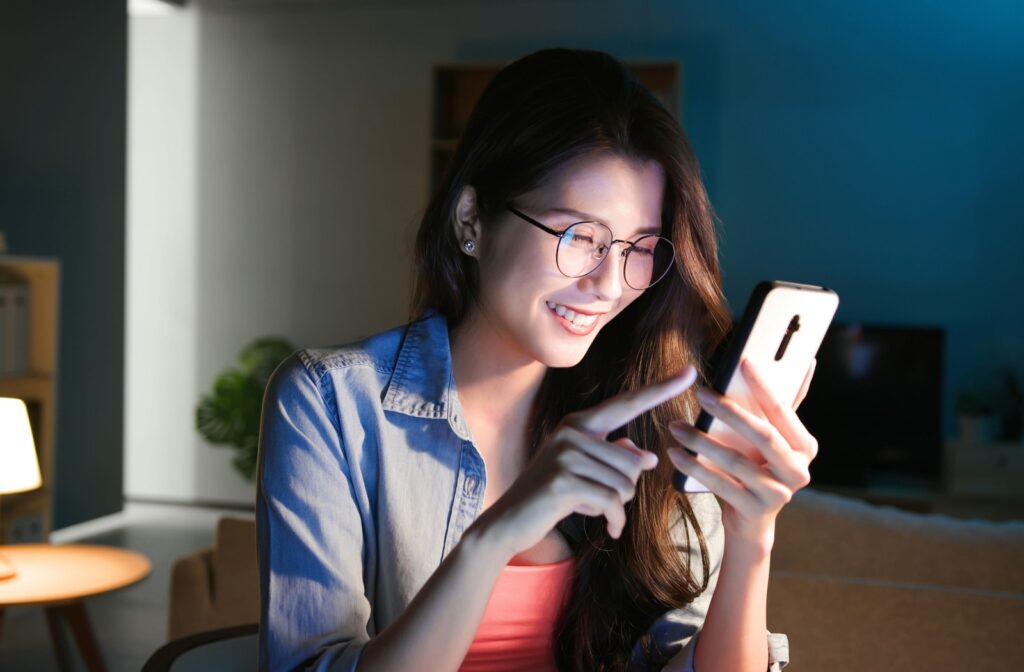Dry eye is one of the most common complaints among people who spend long hours on screens, and blue light glasses are often marketed as a solution. While they may offer some relief from digital fatigue, they do not directly treat or prevent dry eye symptoms.
Understanding Dry Eye Disease
Dry eye disease is caused by poor-quality tears or insufficient tear production. Potential triggers include age, environmental factors, and medical conditions.
Prolonged screen use is one of the most common contributors to dry eye. When we focus on screens, our natural blinking rate decreases significantly. This slows the spread of tears across the surface of our eyes, leading to dryness, irritation, and discomfort often referred to as digital eye strain. Common symptoms of dry eye include:
- Redness and irritation
- Sensitivity to light
- A gritty or sandy feeling in the eyes
- Blurred vision
- Burning or stinging sensation
If this sounds familiar, it’s time to understand how screen habits impact your vision and what tools, like blue light glasses, might accomplish.
What Are Blue Light Glasses?
Blue light glasses are specially designed eyewear equipped to block or filter blue light from digital screens and artificial sources.
Blue light is part of the visible light spectrum, sitting in the wavelength range of 380–500 nanometers. While natural blue light (from the sun) is needed for regulating your sleep-wake cycle, overexposure to artificial blue light can cause discomfort, difficulty sleeping, and, for some, fatigue.
These glasses have lenses with coatings or slight tints that help to diminish the portion of blue light that reaches your eyes. While heavily promoted for combating eye strain and improving sleep, their connection to dry eye management is where things start to fall short.
Do Blue Light Glasses Help With Dry Eye?
The research on blue light glasses and their effectiveness is still emerging, but here’s what we know so far:
Limited Evidence for Dry Eye Relief
A 2023 review from the Cochrane found that blue light glasses don’t significantly improve visual performance or sleep quality beyond standard lenses.
Screen Habits, Not Blue Light, Affect Blinking
Dry eye symptoms caused by reduced blinking during screen use aren’t directly tied to blue light exposure. Instead, they result from prolonged focus without breaks. Wearing blue light glasses won’t inherently fix reduced tear distribution, though they might make screens less abrasive.
Some users report slight improvements in comfort while wearing these glasses, possibly due to reduced overall eye fatigue. However, if dry eye relief is your ultimate goal, there are more effective treatments available.

Potential Treatments for Dry Eye
Unlike blue light glasses, targeted treatments for dry eye focus on addressing the condition’s root cause. Depending on the severity of your symptoms, relief can come from at-home remedies or in-office therapies.
At-Home Remedies
- Artificial tears: Over-the-counter eye drops can supplement your natural tear production and relieve mild dryness.
- Warm compresses: Applying warmth to your eyelids can unclog meibomian glands (which produce the oil in tears) and improve overall tear quality.
- Humidifiers: Adding moisture to the air can reduce tear evaporation in dry climates or during winter heating seasons.
- Blinking exercises: Take regular breaks during screen use by following the 20-20-20 rule. Look at something 20 feet away for 20 seconds every 20 minutes.
Professional Treatments
For more severe cases of dry eye, we can offer in-office therapies:
- Prescription eye drops: Medications like cyclosporine (Restasis) or lifitegrast (Xiidra) address inflammation and improve tear production.
- Punctual plugs: Small devices inserted into the tear ducts can prevent tears from draining too quickly, increasing eye moisture.
- Intense pulsed light (IPL): This therapy targets meibomian gland dysfunction, reducing inflammation and improving tear film balance.
- Supplements: Nordic Naturals Pro-Omega 2000 can be helpful by providing extra omega-3s in your diet for improved eye health.
At Vision Veritas, we offer these state-of-the-art treatments and more. Schedule a consultation with us to personalize your path to lasting dry eye relief.
What to Do If You Have Dry Eyes
Relying on blue light glasses as a solution for dry eye is unlikely to yield significant results. While they might add comfort for digital fatigue, blue light glasses can’t replace targeted treatments designed to address the underlying causes of dryness or irritation. If dry eyes disrupt your daily life, schedule a comprehensive eye exam. At Vision Veritas, we take the time to understand what’s causing your symptoms and offer solutions that fit your needs. From targeted treatments to one-on-one support, we’re here to help you find relief and get back to feeling your best.





